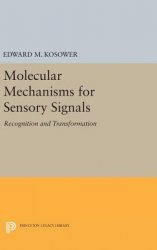Molecular Mechanisms for Sensory Signals: Recognition and Transformation
- Добавил: mihail1000
- Дата: 25-08-2018, 13:36
- Комментариев: 0

Название: Molecular Mechanisms for Sensory Signals: Recognition and Transformation
Автор: Edward M. Kosower
Издательство: Princeton University Press
Год: 2017
Формат: pdf
Страниц: 458
Размер: 21 MB
Язык: English
Pursuing the questions of how we learn and how memory is made, Edward Kosower introduces a novel and rich approach to connecting molecular properties with the biological properties that enable us to write and read, to create culture and ethics, and to think. Here he examines what happens within a single cell in reaction to external stimuli, and shows the parallels between single cell and multicellular responses. To address the problem of "learning, " Kosower explains the molecular mechanisms of responses to input from taste, olfactory, and visual receptors. He then shows how these and other processes serve as the basis for memory.This study covers such signals for the molecular process of learning as pheromones (the molecular signals mediating behavior), light (activates the G-protein receptor, rhodopsin), and acetylcholine (opens the nicotinic acetylcholine receptor). Kosower's discussion of the structure and function of these complex molecules has direct implications for such areas as molecular neurobiology, bioorganic chemistry, and drug design, in elucidating approaches to the structure of drug targets.
Скачать с Depositfiles
Внимание
Уважаемый посетитель, Вы зашли на сайт как незарегистрированный пользователь.
Мы рекомендуем Вам зарегистрироваться либо войти на сайт под своим именем.
Уважаемый посетитель, Вы зашли на сайт как незарегистрированный пользователь.
Мы рекомендуем Вам зарегистрироваться либо войти на сайт под своим именем.
Информация
Посетители, находящиеся в группе Гости, не могут оставлять комментарии к данной публикации.
Посетители, находящиеся в группе Гости, не могут оставлять комментарии к данной публикации.
